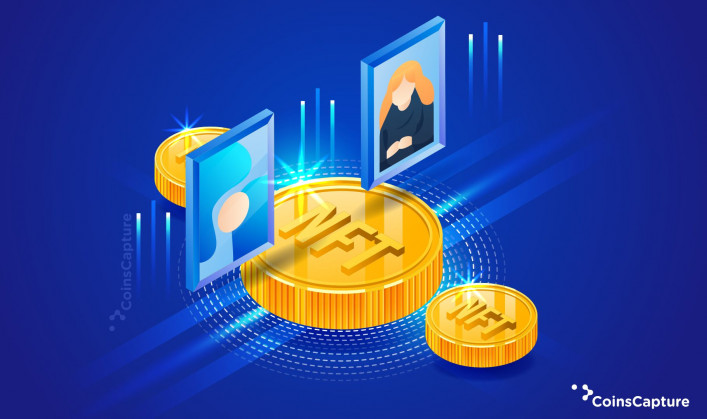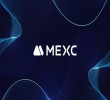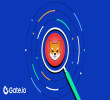7 November 2025
How to convert Digital Artwork into NFT ?
As the popularity and value of digital art grow, more artists realize the importance of selling their work online in a digital form. This allows them to simply extend their NFT Art Market and make money without reducing the art quality. Even artists who haven't yet explored and participated in the digital realm are starting to look at the potential of selling their work online. An NFT may be anything that deals in the real world, from art and music to memes, GIFs, documentation, and more. As per the statistics, NFT sales soared to $10.7 billion in just the third quarter of 2021. It's not complicated, but it's not easy as well to make money using NFTs. Investing in NFT art and collectibles is one way to get engaged in it. Nevertheless, this necessitates some initial investment, particularly if you want to obtain a blue-chip item with a high market value.
Also read: https://coinscapture.com/blog/how-to-identify-a-good-nft-project
An online auction recently sold a GIF for $60,000, even a simple tweet by the Twitter founder Jack Dorsey was sold for $2.9 million. Now, this might be the time to rethink what defines “Fine Art” and research the realm of NFTs. It is worth emphasizing that these works of digital art may be changed without losing any data, and all transactions are completely transparent. NFTs, like every Crypto, may be purchased and sold. Hence, it’s easy because anybody with a computer and access to the internet may now sell their art on the NFT Art Market. All that is required is a little creative imagination, and a good website to showcase your work.
The NFT Art Market’s appeal derives from the fact that artists now have access to new methods for selling their work. Artists may now use cameras to exhibit the beauty of their creations, thanks to the introduction of digital cameras and other video and internet technology. This overall method of selling NFT Art Market has shifted from a one-time show or gallery setting to a much massive and more expensive event as a result of this. Before you get too enthusiastic about the capability of making more money from your creative endeavours, you must first learn how to transform your artwork into NFT digital art for sale.
Step1: Choose the Art:
As mentioned above, NFT may be produced from anything; it can either be songs, drawings, films, or any other digital art. So, first and foremost, find an appropriate piece of artwork that best matches you and your capability. Art is among the most famous NFT categories and one of the most expensive, so if you want to sell your NFT paintings, the most excellent strategy is to shock and astonish your audience. Artists from different fields do precisely that; hence you should take notes from them.
Step 2: Select a Blockchain:
It is important to select a suitable Blockchain platform for issuing NFTs before transforming the art into NFTs. These days, there are a variety of Blockchain platforms to choose from. The NFT token standard, compatible wallet, and marketplace are unique to each Blockchain platform. This implies that an NFT token generated on one Blockchain platform can only be sold and bought on that Blockchain platform. As a result, picking the right Blockchain platform is essential. In the realm of NFT issuance, Ethereum is now at the forefront. Therefore, it is preferable to issue NFTs using Ethereum.
Step 3: Create a Wallet:
Setting up an online wallet to store your NFTs should be your next to generate your own NFT. Crypto-assets are kept in a 'wallet', which may be accessible by providing your 'private key', which is the Crypto equivalent of a super-secure password, and without which the Crypto owner is unable to access the money. MetaMask, TrustWallet, and Coinbase Wallet are examples of Ethereum wallets that support ERC-721, the Ethereum Based NFT token standard. Tezos, Binance Smart Chain, Cosmos, WAX, and more Blockchain systems exist in contrast to Ethereum.
Also read: https://coinscapture.com/blog/5-best-nft-wallets
Step 4: Purchase and Add Cryptos in your Wallet:
In most digital art marketplaces, there are fees associated with converting digital art into an NFT. So, to continue, one must first acquire a certain amount of Ethereum. That's because it is expensive to mint an NFT. Minting is the process that authenticates your artwork on the Blockchain. So when it's on the public ledger, and it can't be copied, duplicated, or altered. If you wish to sell your NFT, minting is required. In most circumstances, you'll have to pay the gas price upfront for your NFT to be validated on the Blockchain. On the other hand, some marketplaces allow for lazy minting, which means that it is minted during the transaction while you are selling it.
Step 5: Connect your Wallet to the NFT Marketplace:
There are several marketplaces, each with its own set of advantages. On music-focused platforms like Catalog or Async Music, NFTs especially from unsigned acts, sell higher. So, after acquiring Cryptocurrency, it’s time to list NFT by selecting a suitable marketplace. Newbies should join NFT in Rarible. This is the most basic arrangement and is appropriate for beginners. After deciding on a platform, the final step is to choose a Coinbase or any other wallet to complete the process- it’s a transaction.
Step 6: Create an NFT Artist Account and Sell NFTs:
It's time to convert the digital art into NFT once the wallet is set to use. To do just that, simply create an account on the site and register as an artist. A 'Create' button may be found in the upper right corner of any NFT-centric forum. Simply click on that button, and you will be requested to connect with Ethereum wallet. For further protection and security, a digital signature may be required. From there one may find the location of 'my collections'. Next, a new window will appear, allowing the user to upload their digital work along with the title and description. This is a necessary step in the creation of the NFT folder. After you've finished uploading, click on the pencil symbol to add a banner to the page. This completes the process of creating a new artist NFT account. The next step is to write a description of your file and post it to the marketplace. Usually, this is a relatively simple task. The title and description are two things to consider carefully. To persuade the audience to purchase, you want to make it as appealing and informative as possible. Also, check out what file types the marketplace accepts before uploading your artwork. Most of them support PNG, GIF, jpg, and MP3 files. After that, click 'CREATE' and your artwork will begin to load.
Also read: https://coinscapture.com/blog/how-to-store-nft-assets
You may have the opportunity to choose how to sell your NFT at this time. For example, you can pick between a fixed price and an auction approach. There could be an option between a continuous auction under the falling price when it comes to auctions. In other words, the auction proceeds until someone is willing to pay the price. You may pick how you wish to sell it at this point. If you'd like, you may specify the minimum price or manually accept a bid. Lastly, if your NFT is resold, you may choose the percentage of royalties you want to receive. But be careful to consider all of your options. If your price it's too high, the motive to resale will be lost, and if it's too low, you'll make very little money from it in the future, and it may not be as profitable as you might think.
Therefore, you've now completed the creation of your NFT and how to sell them. The artist profits from the one-time sale of their artwork and the NFT tokens for as long as they exist. It's not difficult to transform anything amazing into NFT and sell it if one can make something exceptional. It's simple to set up; thus, everyone can do something. As you've read above, the procedure is straightforward; all you need to do is follow the steps and processes to generate and sell NFT. If you succeed, you will make a lot of money in the future.
Disclaimer: The author’s thoughts and comments are solely for educational reasons and informative purposes only. They do not represent financial, investment, or other advice.






